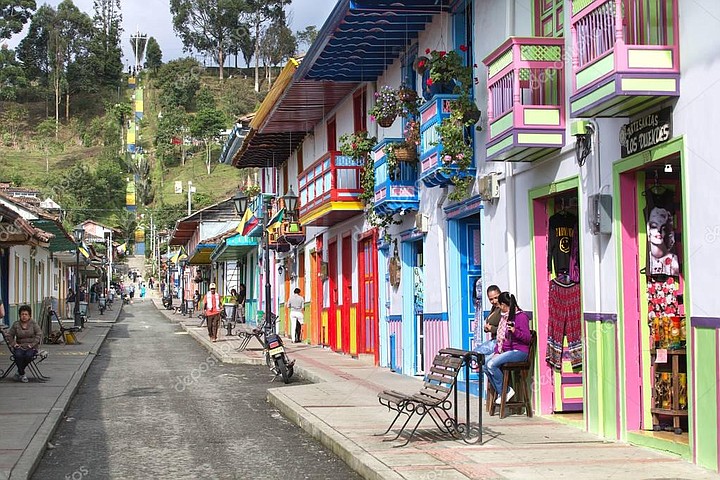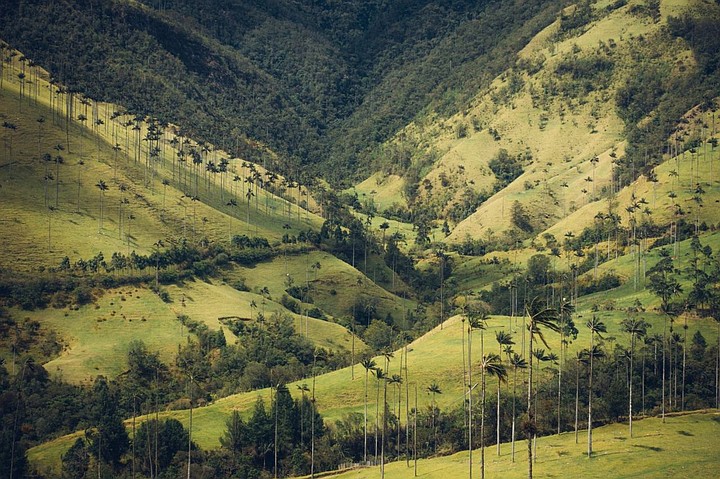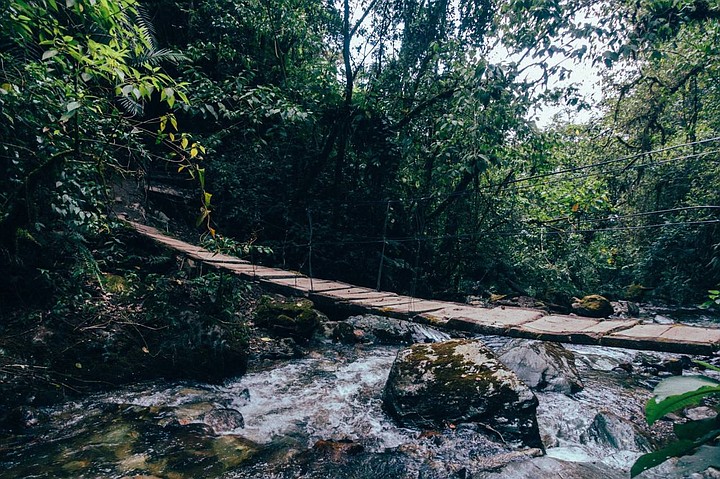 Facebook
Facebook
 X
X
 Instagram
Instagram
 TikTok
TikTok
 Youtube
Youtube

Salento is an historic colonial town high in the mountains of the department of Quindio, situated 250 kilometers due south of Medellin. It used to be on the main route between Bogota and Popoyan even further south, and was visited by Simon Bolivar himself back in the day.

Today it's a premier tourist destination due to its proximity to the highest mountains in the area — the most prominent, Nevada de Quindio, attains 4,750 meters, or 15,583 feet. Salento is also a major hub for Colombian coffee, with dozens of farms in the area. It's a pretty village which has become a very popular place on weekends for locals and tourists alike.
The easiest way to reach the town from Medellin is by bus, although this journey can take 9 hours instead of the stated 6. The road between Medellin and Salento, Highway 25, is in a constant state of repair, with several sequences of single lanes where traffic is alternated. There are a number of toll booths, and once up and out of the Aburra Valley south of Medellin, the landscape becomes very scenic.
It's such a windy route, loaded with switchbacks, that it's a fine idea to let somebody else drive in order to enjoy the stupendous views. However, if you have a tendency towards motion sickness you're going to get it here, and bags are provided to passengers.
The most frequent and recommended carrier, Flotas Occidental, stops along the way in both Manizales and Pereira on the way to Armenia. From Armenia, the local bus to Salento takes 40 minutes to an hour — but it's possible to have the driver drop you at the turnoff to Salento, about 20 minutes past Pereira. This move can save lots of time, as the local bus passes by every 20 minutes or so on the way into town, 15 minutes away. Upon arrival, there are multiple choices for accommodations in the central area, as well as heaps more just out of the center.

It's a mellow community, except on big weekends, with lots of cafes and restaurants, most featuring the local trout specialties. The main square in front of the very prominent church is where more transportation choices are available.
These are the jeeps that will haul outdoor enthusiasts to the assorted sites of interest — the most worthwhile of which is the stunning Valle de Cocora a half hour to the northeast. Cocora is famous for its absurdly tall wax palms, 60 meters high, but also boasts some of the loveliest terrain in Colombia. For those with enough energy and time to spend, it's surely one of the best day hikes in the world.

A 12-kilometer loop starts at the jeep drop-off, and gradually climbs up the valley through very pretty farmland. This trail follows a crystal-clear stream through increasingly lush terrain, and before long it's solid rainforest, reminiscent of Costa Rica or Hawaii. There are a number of small falls, with pools ideal for a quick swim, and the path crosses muddy, rocky earth. Next comes a series of very rickety wooden bridges that only add to the fun, and a trail junction is reached after about 5 kilometers. This sign leads towards the beautiful Acaime Nature Reserve, and the sign states that it is a kilometer away but is actually at least double that. The trail steepens as it climbs up the mountain, and another junction is reached. A left leads to La Montana, but the right fork goes further up up up to Acaime. This is where guides leave their horses before the last short stretch.
The only charge on this loop is to enter the reserve and make it to the Colibri house that is famed for its marvelous hummingbirds. 5000 Colombian pesos also provides a hot or cold drink of choice, and this is worth every bit of that two and a half bucks. After a spell watching the hyper twitch little birds, it's back down the path to the junction, and now up a very relentless, steep climb to La Montanita. This leg attains another 400 meters elevation, but from the top it's all downhill.
This finca is extraordinarily pretty, and seems like an alpine farm in Switzerland. There are no services available, nor food or drink, but it's a splendid place to sit among the flowers and enjoy an astounding view. After several hours of steady climbing, from here a rough road drops almost 1000 meters back down to the valley floor. First, a pine cloud forest is passed through, and another couple of k's reaches the first of the wax palms, among the tallest in the world. Lots of birds and rodents are in these woods, including at least one dazzling iridescent trogon, a cousin of the sacred bird of the Mayas, the quetzal. Gradually the trees thin out and the farmland is reached, and depending on how many pictures are taken, this loop will take between five and seven hours. The last jeep back to Salento leaves at 5, and no matter how long this takes, it's time extremely well spent.

Take that jeep back to town, get some delicious grub at Brunch on Calle Real, which leads three blocks to the main plaza, and reflect on one of the best days ever. I recommend staying at La Serrana a kilometer and a half south of town on Carrera 5. It's an eco farm and hostel with camping facilities, and all the amenities on a hill you may never want to leave.
Salento is special.
Interested in visiting off-the-beaten-path Colombia? Keep reading here.


Salento is an historic colonial town high in the mountains of the department of Quindio, situated 250 kilometers due south of Medellin. It used to be on the main route between Bogota and Popoyan even further south, and was visited by Simon Bolivar himself back in the day.

Today it's a premier tourist destination due to its proximity to the highest mountains in the area — the most prominent, Nevada de Quindio, attains 4,750 meters, or 15,583 feet. Salento is also a major hub for Colombian coffee, with dozens of farms in the area. It's a pretty village which has become a very popular place on weekends for locals and tourists alike.
The easiest way to reach the town from Medellin is by bus, although this journey can take 9 hours instead of the stated 6. The road between Medellin and Salento, Highway 25, is in a constant state of repair, with several sequences of single lanes where traffic is alternated. There are a number of toll booths, and once up and out of the Aburra Valley south of Medellin, the landscape becomes very scenic.
It's such a windy route, loaded with switchbacks, that it's a fine idea to let somebody else drive in order to enjoy the stupendous views. However, if you have a tendency towards motion sickness you're going to get it here, and bags are provided to passengers.
The most frequent and recommended carrier, Flotas Occidental, stops along the way in both Manizales and Pereira on the way to Armenia. From Armenia, the local bus to Salento takes 40 minutes to an hour — but it's possible to have the driver drop you at the turnoff to Salento, about 20 minutes past Pereira. This move can save lots of time, as the local bus passes by every 20 minutes or so on the way into town, 15 minutes away. Upon arrival, there are multiple choices for accommodations in the central area, as well as heaps more just out of the center.

It's a mellow community, except on big weekends, with lots of cafes and restaurants, most featuring the local trout specialties. The main square in front of the very prominent church is where more transportation choices are available.
These are the jeeps that will haul outdoor enthusiasts to the assorted sites of interest — the most worthwhile of which is the stunning Valle de Cocora a half hour to the northeast. Cocora is famous for its absurdly tall wax palms, 60 meters high, but also boasts some of the loveliest terrain in Colombia. For those with enough energy and time to spend, it's surely one of the best day hikes in the world.

A 12-kilometer loop starts at the jeep drop-off, and gradually climbs up the valley through very pretty farmland. This trail follows a crystal-clear stream through increasingly lush terrain, and before long it's solid rainforest, reminiscent of Costa Rica or Hawaii. There are a number of small falls, with pools ideal for a quick swim, and the path crosses muddy, rocky earth. Next comes a series of very rickety wooden bridges that only add to the fun, and a trail junction is reached after about 5 kilometers. This sign leads towards the beautiful Acaime Nature Reserve, and the sign states that it is a kilometer away but is actually at least double that. The trail steepens as it climbs up the mountain, and another junction is reached. A left leads to La Montana, but the right fork goes further up up up to Acaime. This is where guides leave their horses before the last short stretch.
The only charge on this loop is to enter the reserve and make it to the Colibri house that is famed for its marvelous hummingbirds. 5000 Colombian pesos also provides a hot or cold drink of choice, and this is worth every bit of that two and a half bucks. After a spell watching the hyper twitch little birds, it's back down the path to the junction, and now up a very relentless, steep climb to La Montanita. This leg attains another 400 meters elevation, but from the top it's all downhill.
This finca is extraordinarily pretty, and seems like an alpine farm in Switzerland. There are no services available, nor food or drink, but it's a splendid place to sit among the flowers and enjoy an astounding view. After several hours of steady climbing, from here a rough road drops almost 1000 meters back down to the valley floor. First, a pine cloud forest is passed through, and another couple of k's reaches the first of the wax palms, among the tallest in the world. Lots of birds and rodents are in these woods, including at least one dazzling iridescent trogon, a cousin of the sacred bird of the Mayas, the quetzal. Gradually the trees thin out and the farmland is reached, and depending on how many pictures are taken, this loop will take between five and seven hours. The last jeep back to Salento leaves at 5, and no matter how long this takes, it's time extremely well spent.

Take that jeep back to town, get some delicious grub at Brunch on Calle Real, which leads three blocks to the main plaza, and reflect on one of the best days ever. I recommend staying at La Serrana a kilometer and a half south of town on Carrera 5. It's an eco farm and hostel with camping facilities, and all the amenities on a hill you may never want to leave.
Salento is special.
Interested in visiting off-the-beaten-path Colombia? Keep reading here.
Comments